Driving in China – Prepare for the Chinese Motorcycle License Test
This is the first in a series of articles that will help beginners learn to travel by motorcycle in China. In this and the articles that follow, we will cover topics such as why travel by motorcycle in China, how to get your Chinese driver’s license, where to buy a motorcycle in China and what kind of motorcycle you should buy, on what roads can you travel by motorcycle in China, what place in China might foreigners be restricted from traveling through, and what you should bring with you on your trip.
This article addresses the following questions:
- Why travel by motorcycle in China?
- What might be difficult about traveling by motorcycle in China?
- How do you study and prepare for the Chinese driver’s license test?
Why travel by motorcycle in China?
Traveling by motorcycle in China is not for everyone, but in my opinion, there’s nothing better and no better way. I first got the idea when I was traveling there during the summer of 2005 and, like most people, took buses and trains to get where I was going.
As I stared out of the window at the passing landscapes with delight and wonder, at the scenes of farming, small towns, and villages, I would think to myself, “Gee, I wish, on my way to . . . I could visit that place for a while.” In fact, that’s exactly what I started doing. I took to getting off the bus or train in the middle of points A and B, staying at random places whose name I didn’t even know until I’d gotten off.
So it was during this summer and through these events that it began to occur to me that if I was traveling China by motorcycle, I could not only stop whenever and wherever I wanted, but I could also take random detours whenever and to wherever I wanted. In China, there are routes to be traveled that any other vehicle can’t make it through.
What difficulties might you encounter while traveling by motorcycle in China?
There are innumerable small villages filled with friendly and welcoming ethnic peoples; but to get to them sometimes one must traverse very small dirt and gravel roads, that in some places become little more than paths and where no public transportation is available.
One must cross make-shift bridges over small streams that are nothing more than a bunch of logs set side-by-side, when the bridges are out drive across rivers, or take shortcuts in places where there is no road at all, where you find your way only by following the pressed down grass and tracks of those Chinese people who on their own motorcycle have passed that way ahead of you.
You might find yourself in remote villages that don’t have anything like a hotel, and ask to be lodged in the house of a local, or at a local Buddhist monastery. During my travels by motorcycle in China, I’ve done all these things.
Is this kind of adventure traveling in China for you? If so, it’s well within reach, and hopefully, this article and those that follow will clearly explain everything you need to do to get started. Once you have the basics down, head over to part two!
The first thing to get started: prepare for your Chinese driver’s license test.
The first consideration is getting your Chinese driver’s license, and the first consideration to that end is to study for the theoretical test. (Some might call this a “written” test, but since it’s delivered by computer and no actual writing is involved I use the word “theoretical.”)
If you arrive in China with a valid driving license from your home country you won’t need to take the practical, or the driving test; the theoretical test is the only one you need to worry about.
Is it difficult to pass the Chinese driving license test?
It took me three tries to pass, which is typical. For each time you pay to take the test you can try twice, but those two tries must be on the same day. The test can be delivered in eight different languages, including English.
You take it on a computer that randomly selects multiple choice and true or false questions from a database. You will be required to answer a total of one-hundred, and the lowest passing grade is ninety correct answers.
If you bring a USB drive to your local Chinese Vehicle Administration Department, they will download onto your drive the entire database of questions with the correct answers so you can study for the test.
The study guide that was downloaded onto my USB drive and the test I took were all in my mother tongue, which is English. But there’s a caveat to this convenience. The English was so bad it made many of the questions misleading, nonsensical, and some of the differences in the multiple choice answers negligible to the extent that two or more were basically the same answer worded differently.
Answering questions like these is simply a matter of remembering the question and memorizing which answer is the one that will be counted as correct.
An example of a Chinese driving license test question:
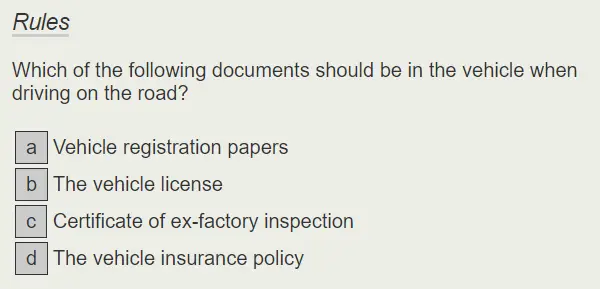
Actually, the correct answers to this question are A, C, and D. The only one of these that doesn’t need to be in the vehicle is B, (the license plate) which should be on the vehicle.
The question is worded wrong, so which answer to give is very confusing. If you read the database of questions, you can probably remember one like this because it doesn’t make sense and will stand out, so remembering the question and memorizing the answer that will be counted as correct is not that hard.
More examples of Chinese driver’s license test questions
There are more examples of “bad English questions” at the end of this article. They can be read for your enjoyment and/or edification.
Other aspects of the Chinese driving license test
Some of the questions had absolutely no relevance to the type of license I was getting; for example, “What’s the minimum height one must have to get a certain class of truck driving license?” For all the above types of questions, you’ll need to use the study guide and memorize the answer.
I found myself laughing at some points during the test because many of the questions are about things a driver should never do, and are things that most Chinese drivers do every time they drive.
A lot of the questions are simple driving common sense and if you read the question and answer in the study guide once, you’ll almost certainly get these types of questions right when they appear on your particular test.
So that’s the first chore I recommend you tackle, properly studying for the test.
A website that can help you study for the Chinese driver’s license test
If you want to practice test questions, this website provides an authentic simulation of an actual test, though it may not cover every question that might come up on your particular test: http://www.chinesedrivingtest.com/.
But before you take the test you’ll have to wade through the bureaucracy at the Chinese Vehicle Administration Department. I’ll explain that in the next article.
Some more examples of “bad English test questions” that might appear when you take the Chinese driver’s license test
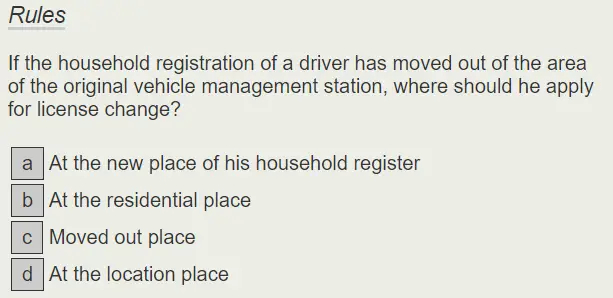
I know that A is the correct answer to this question, and what they mean is that if you move to a new area served by a different Vehicle Administration Department, you should go there with your passport and new address registration document and have the address changed on your Chinese driver’s license. Though it might not be so obvious to someone new to China and the other three answers are meaningless.
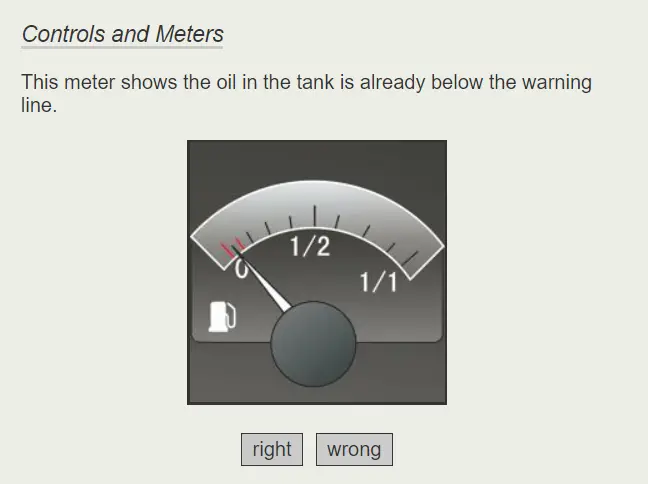
This question uses the term “oil tank.” Now a car does have something one might call an oil tank; in American English, we call it the “oil pan.” But if you notice the icon in the far lower left corner of the illustration, you realize you’re looking at a gas gage, not an oil gage. They mean the gas in the tank, not the oil in the tank.
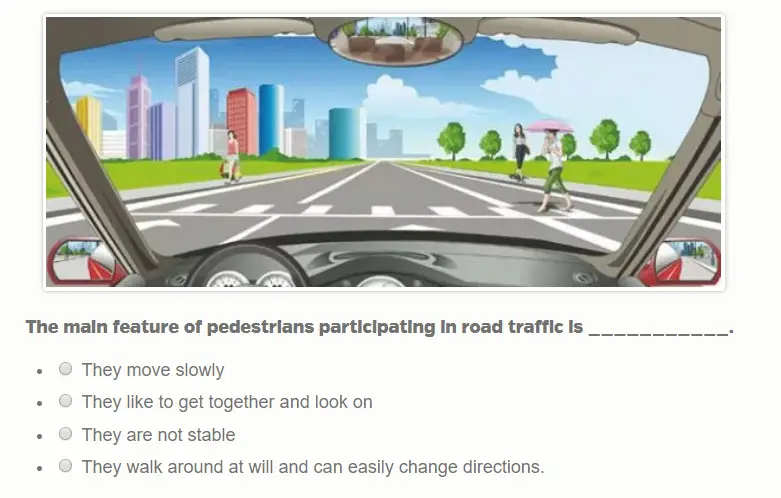
The answer that will be counted as correct to this question is actually the last one: “They walk around at will and can easily change directions.” But since that sounds like such a weird thing to say in English one would likely be compelled to choose the first answer.
The third answer is an example of the sometimes quite funny “Chinglish” one often encounters on signs in China. To say “They are not stable” could perhaps mean they have some kind of psychiatric disorder.
We ought sincerely hope that a psychiatric disorder is not the main feature of pedestrians participating in road traffic in China. But, as a word of warning to the uninitiated, I do sometimes fear it might very well be a prominent one.
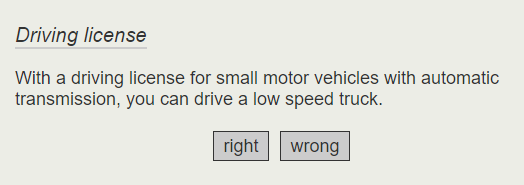
The term “small motor vehicle” means a car, as opposed to a truck. But here it’s very unclear what is meant by “low-speed truck,” There are some three-wheeled vehicles that are something like half motorcycle and half mini pickup truck. This question might be referring to one of those, but probably not. Normal trucks all have the capacity to go the same speed as cars so it doesn’t really make sense to refer to “a low-speed truck” They probably mean. “drive a truck at low speed.”
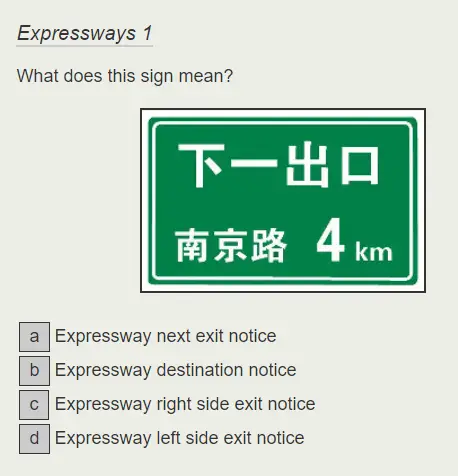
This sign says that the next exit ramp off the expressway is four kilometers away, and after taking that exit ramp you’ll be on Nanjing road. But since expressway exit ramps are always to the right, it’s difficult to determine whether A or C is the answer that will be counted as correct. Technically both are correct. For a question like this, you’ll have to memorize which answer to choose.

A car park (answer A) and a parking area (answer D) are the same things. It’s uncertain what is meant by “service area” (answer C), but judging from the sign it could be a place where you can get a cup of coffee, or maybe it’s a place where you can get your car serviced, or both. In any case, I think we all hope that a place where you park your car and/or get some kind of service is a “safety place.”
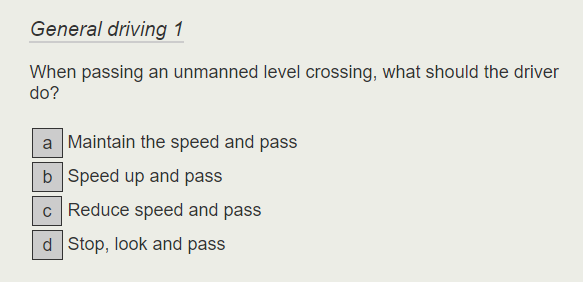
What is an “unmanned level crossing?” This term and others similar to it (manned level crossing, level crossing) appears in the test questions often. I’m not sure what is meant by this term, perhaps some sort of overpass, or maybe a crosswalk.
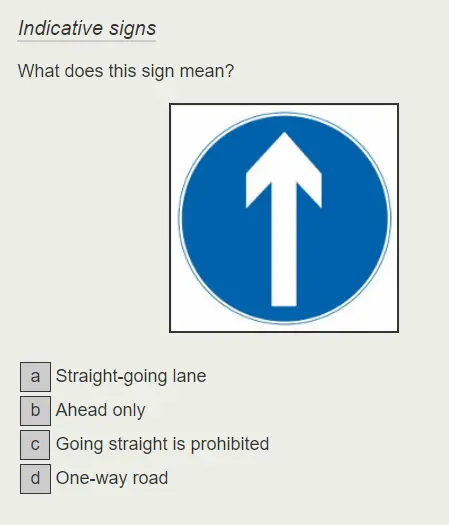
Answer A, a “straight-going” lane and Answer B, “ahead only” are essentially the same thing. A lane where you are supposed to, or can only go straight, is a lane where you can only, or are only supposed to go ahead. Again, this is the type of “bad English question” whose correct answer will have to be memorized.





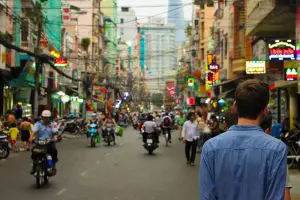


Good stuff had a question. Your licesence was for a car or motorcycle? I’ve got a car license and I’m wondering if I wanted to get a motorcycle would I need to go back and take another written test??
Thank you, you are a generous and good minded human being!
Thank you very much for this content. It is very kind of you that you share your knowledge with others. I really appreciate that.
Hey.
Thanks for the info. I’m looking to apply for a motorcycle licence in Shanghai. I don’t have any motorcycle licence already, do you know if there’s a practical road test involved? If so, could you tell me what it’s like.
Thanks
Hello, the post is a bit older but I hope things didn’t change much. To get a moto driving license you need to have first a car license or you don’t need it? In Spain for instance, to get a drive motos over certain xxx-cc you need to have had a car license for a few years.
Hello Lou, I don’t want to confirm as things may have changed in the past few years. I have been living in Taiwan recently but my thoughts are that a car license is not needed in order to get a motorcycle license in China. However, my understanding is that a foreign or local car license is very helpful. Without a car license, you will need to take driving classes in order to get a motorcycle license – in addition to the written test.
Not sure when this was written, but I tried to do the test in Guilim recently and they have no English version for the motorbike test.
same thing happen to me today so what is the solution